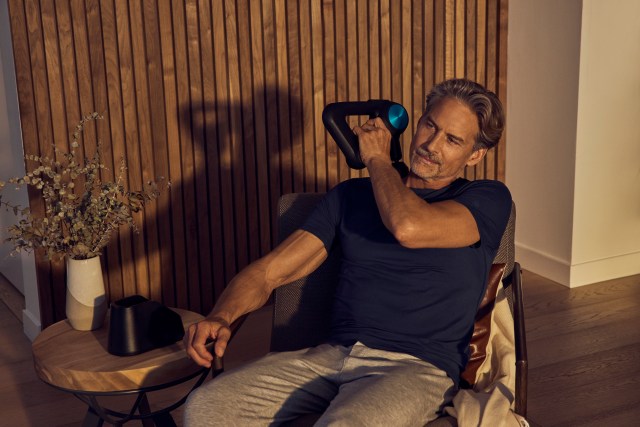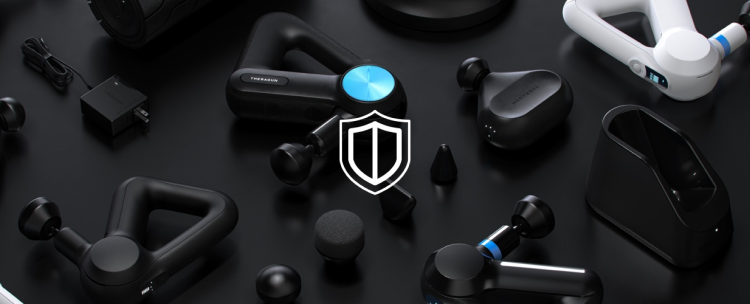Authors: Therabody Scientists: Tim Roberts, MSc; Kyle Silvey, PhD; Michelle Darian, MS, MPH, RD, LDN
You may know of the Theragun as a powerful tool for exercise recovery — but a recent study shows that it can also improve sleep. Theragun’s powerful percussive therapy has been scientifically shown to reduce pain and tension, improve range of motion, increase circulation, and maximize recovery — outcomes essential for those focused on their fitness. But time and time again, Therabody scientists heard that those who used their Theragun before bed rave about how the device helped them sleep. And as a science-first company, Therabody’s scientists were eager to study these anecdotal claims in a controlled setting.
Now, sleep is absolutely crucial for everything that we do. It helps us feel energized, alert, emotionally stable, and ready to take on the day physically. It also plays an exceptional role in recovery processes — helping cells and muscles grow and repair from exercise. [1] And not only can a good night’s rest improve how we feel the next day, but consistently getting restful sleep can also improve many long-term health outcomes. But sleep is also something that many of us struggle with. In fact, about one in three adults in the United States report falling short of the recommended seven to nine hours of sleep nightly. [2]
If using a Theragun can improve measures of sleep, it can be a game changer for athletic recovery and for people who are looking to improve their health and wellness (and reduce their risk of obesity, type 2 diabetes, hypertension, cardiovascular disease, anxiety, depression, and neurological disorders) without prescription aids.
So, the natural next step was to understand if these anecdotal findings held true in a scientific study. Therabody scientists collaborated with Biostrap Labs, a wearable and health tech company, to investigate how using the Theragun impacts measures of sleep, performance, and recovery. The results show that the Theragun may be an effective tool.
Let’s dive deeper into the study and the results.
How Was the Study Set Up?
A total of 73 healthy, active people (between the ages of 18 and 40) participated in this five-week study. For the entire study, everyone wore the Biostrap sensor on their wrist. This device captured data related to sleep (like sleep duration, efficiency, etc.) and recovery (like heart rate and heart rate variation or HRV).
Participants followed their typical routine during weeks one and two and did not use the Theragun. During weeks three and four, all participants followed a post-exercise protocol with the Theragun and a sleep protocol before going to bed at night. The post-exercise protocols, available in the Therabody app, instruct participants to use their Theragun relative to the exercise they had just completed. The sleep protocol, also available in the app, is a six-minute Theragun routine designed to be completed in the 30 minutes leading up to bedtime.
For the last week of the study (week five), participants reverted back to their normal routine without Theragun percussive therapy. The study analysis was performed on trend data relative to the pre-intervention baseline, intervention, and washout period.
Results Show That Theragun Improves Sleep
During the two-week Theragun intervention period, participants improved all sleep measures.
- 87% of participants fell asleep faster (on average, 4 minutes and 15 seconds faster each night)
- 70% of participants experience more efficient sleep (and on average woke up 7% less each night)
- 56% of participants had a better sleep score (meaning a combination of their sleep duration, time spent in deep sleep, and number of awakenings improved)
Considering that the Theragun treatment phase of this study was just two weeks, these results show the immediate impact this tool can have on sleep. Results from previous studies have shown that various forms of vibration and pressure have a calming and balancing effect on the nervous system that may help with sleep. But there’s still more to uncover about the mechanism behind how massage guns have this particularly potent effect on sleep.
And because sleep is integral to overall health, performance, and recovery, researchers wanted to capture recovery and performance data from percussive therapy as well. [3]

Recovery + Performance Metrics Also Improved
Scoring better on metrics like heart rate and HRV are linked to improved overall health, longevity, and performance. [4,5]
A lower heart rate is generally considered more desirable — as it indicates that the heart is working with ease to pump blood throughout the body.
HRV refers to the variation of time between heartbeats. A higher HRV is generally considered more favorable than a lower one. [6,7,8] A higher HRV indicates that the body’s nervous system is flexible and can adapt quickly to any new situation or stressor (like exercise) that inevitably arises.
Participants’ pain and soreness scores were also captured. Theragun’s percussive therapy has previously been shown to help reduce aches and pains — whether from exercise, standing all day, or sitting at a desk.
During this particular study, participants who followed the Theragun protocols saw a:
- 9% reduction in their pain rating
- 10% improvement in vascular function (essential in blood pressure regulation)
- 25% improvement in HRV
- 5% reduction in soreness and daily discomfort
- 67% improvement in recovery score (a combination of heart rate, HRV, sleep duration, and sleep efficiency)
What’s more, participants continued to experience these improvements in the washout week following the Theragun treatment — demonstrating the lasting physiological effects of using the massage gun.
And most importantly, 100% of participants reported improvements in overall quality of life and said they would recommend a Theragun to others.
Why Do These Results Matter?
Sleep is the crux of good health, peak performance, and optimal recovery. While these outcomes may seem only relevant to serious athletes or gym goers, everyone can improve their well-being and long-term health by getting good sleep. These results also highlight the recovery and sleep benefits people can experience when following science-backed Theragun device protocols. That’s why Therabody scientists worked with third-party sleep experts at Biostrap Labs to validate the Theragun device and in-app protocols in a real-life setting.
Getting consistent, quality sleep can help improve memory and concentration, hormone regulation (especially those tied to appetite and satiety), and inflammation. [9,10,11] Sufficient sleep can also help ward off preventable chronic diseases like heart disease and type 2 diabetes, and can even lead to a longer life expectancy. [12,13]
Nearly nine million Americans rely on prescription sleep aids to help remedy a shortfall in sleep. [14] But prescription medication comes with its own set of risks and isn’t a long-term sleep solution, nor does it address the root cause of one’s sleep problem.
Adding in Theragun use is not only an effective way to naturally help relax your muscles and ease you into sleep, but it’s also enjoyable — meaning you’re more likely to stick with it.
Key Takeaways
- Massage guns like the Theragun are most known for their benefits on muscle health and recovery.
- A study conducted by Theragun scientists also found that using the Theragun post-exercise and before bed improves measures of sleep in addition to measures of performance and recovery.
- Many participants fell asleep faster, slept more soundly (without disruptions), and improved their sleep score with just two weeks of regular use of the Theragun.
- Participants’ recovery scores also improved (by 67%), and they retained this improvement even after the two-week Theragun treatment phase ended.
- Using the Theragun before bed may be an effective (non-prescription) method to improve your sleep and overall well-being.
References
- https://pubmed.ncbi.nlm.nih.gov/28673415/
- https://www.nhlbi.nih.gov/health/sleep-deprivation
- https://pubmed.ncbi.nlm.nih.gov/25061767/
- https://pubmed.ncbi.nlm.nih.gov/33041862/
- https://pubmed.ncbi.nlm.nih.gov/34360435/
- https://pubmed.ncbi.nlm.nih.gov/29034226/
- https://pubmed.ncbi.nlm.nih.gov/9502641/
- https://www.ahajournals.org/doi/10.1161/01.CIR.93.5.1043
- https://pubmed.ncbi.nlm.nih.gov/21532950/
- https://pubmed.ncbi.nlm.nih.gov/36404495/
- https://pubmed.ncbi.nlm.nih.gov/21835655/
- https://pubmed.ncbi.nlm.nih.gov/35881527/
- https://pubmed.ncbi.nlm.nih.gov/27067616/
- https://pubmed.ncbi.nlm.nih.gov/24152538/







